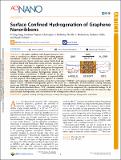Files in this item
Surface confined hydrogenation of graphene nanoribbons
Item metadata
| dc.contributor.author | Sung, Yi-Ying | |
| dc.contributor.author | Vejayan, Harmina | |
| dc.contributor.author | Baddeley, Christopher John | |
| dc.contributor.author | Grillo, Federico | |
| dc.contributor.author | Richardson, Neville V | |
| dc.contributor.author | Schaub, Renald | |
| dc.date.accessioned | 2022-07-07T15:30:08Z | |
| dc.date.available | 2022-07-07T15:30:08Z | |
| dc.date.issued | 2022-07-26 | |
| dc.identifier | 280285404 | |
| dc.identifier | 47c066e7-b1d6-4e57-ac74-a966aee6aa39 | |
| dc.identifier | 000826925200001 | |
| dc.identifier | 85136049761 | |
| dc.identifier.citation | Sung , Y-Y , Vejayan , H , Baddeley , C J , Grillo , F , Richardson , N V & Schaub , R 2022 , ' Surface confined hydrogenation of graphene nanoribbons ' , ACS Nano , vol. 16 , no. 7 , pp. 10281–10291 . https://doi.org/10.1021/acsnano.1c11372 | en |
| dc.identifier.issn | 1936-0851 | |
| dc.identifier.other | ORCID: /0000-0001-9750-6494/work/115630922 | |
| dc.identifier.other | ORCID: /0000-0001-9961-1212/work/115631004 | |
| dc.identifier.uri | https://hdl.handle.net/10023/25629 | |
| dc.description | YYS acknowledges support from the Funds for Women Graduates (GA-00558). FG and CJB acknowledge support from EPSRC through Grants EP/M029077/1 and EP/S027270/1. RS acknowledges financial support from the Scottish Funding Council through SRD-Grant HR07003. | en |
| dc.description.abstract | On-surface synthesis with designer precursor molecules is considered an effective method for preparing graphene nanoribbons (GNRs) of well-defined widths and with tunable electronic properties. Recent reports have shown that the band gap of ribbons doped with heteroatoms (such as boron, nitrogen, and sulfur) remains unchanged in magnitude in most cases. Nevertheless, theory predicts that a tunable band gap may be engineered by hydrogenation, but experimental evidence for this is so far lacking. Herein, surface-confined hydrogenation studies of 7-armchair graphene nanoribbons (7-AGNRs) grown on Au(111) surfaces, in an ultrahigh vacuum environment, are reported. GNRs are first prepared, then hydrogenated by exposure to activated hydrogen atoms. High resolution electron energy loss spectroscopy (HREELS) and scanning tunneling microscopy (STM) images reveal a self-limited hydrogenation process. By means of a combination of bond-resolved scanning tunneling microscopy (BRSTM) imaging and tip-induced site-specific dehydrogenation, the hydrogenation mechanism is studied in detail, and density-functional theory (DFT) calculation methods are used to complement the experimental findings. In all cases, the results demonstrate the successful modification of the electronic properties of the GNR/Au(111) system by edge and basal-plane hydrogenation, and a mechanism for the hydrogenation process is proposed. | |
| dc.format.extent | 11 | |
| dc.format.extent | 8407265 | |
| dc.language.iso | eng | |
| dc.relation.ispartof | ACS Nano | en |
| dc.subject | Scanning tunneling spectroscopy | en |
| dc.subject | Nanoribbons | en |
| dc.subject | Graphene | en |
| dc.subject | Hydrogenation | en |
| dc.subject | Scanning tunneling microscopy | en |
| dc.subject | QD Chemistry | en |
| dc.subject | DAS | en |
| dc.subject.lcc | QD | en |
| dc.title | Surface confined hydrogenation of graphene nanoribbons | en |
| dc.type | Journal article | en |
| dc.contributor.sponsor | EPSRC | en |
| dc.contributor.sponsor | EPSRC | en |
| dc.contributor.sponsor | Scottish Funding Council | en |
| dc.contributor.institution | University of St Andrews. EaSTCHEM | en |
| dc.contributor.institution | University of St Andrews. School of Chemistry | en |
| dc.contributor.institution | University of St Andrews. Institute of Behavioural and Neural Sciences | en |
| dc.identifier.doi | 10.1021/acsnano.1c11372 | |
| dc.description.status | Peer reviewed | en |
| dc.identifier.url | https://europepmc.org/article/MED/35786912 | en |
| dc.identifier.grantnumber | EP/S027270/1 | en |
| dc.identifier.grantnumber | EP/M029077/1 | en |
| dc.identifier.grantnumber | SCISS HR07003 | en |
This item appears in the following Collection(s)
Items in the St Andrews Research Repository are protected by copyright, with all rights reserved, unless otherwise indicated.

